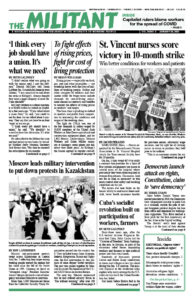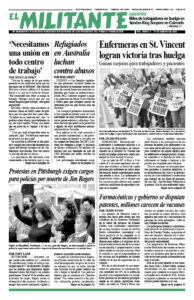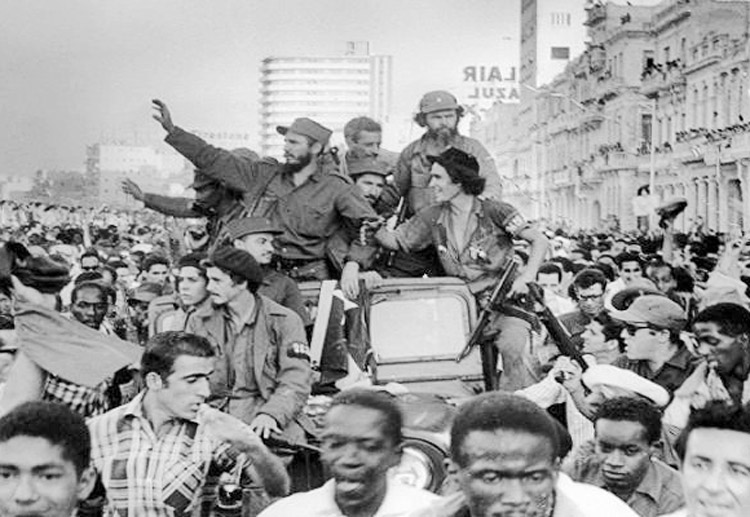Sixty-three years ago, after the U.S.-backed dictator Fulgencio Batista fled Cuba, Fidel Castro led the “Caravan of Freedom” from Santiago, in the east, to Havana, as part of the victorious rebel forces organizing workers and farmers to take political power into their own hands.
Hundreds of thousands greeted Castro and Rebel Army combatants in towns and villages across the island during the Jan. 1-8 caravan. The massive response to the revolution helps explain why every attempt by the U.S. rulers to turn back the Cuban Revolution has failed.
Just hours before Batista fled in the early morning of Jan. 1, 1959, State Department officials sent a telegram to Washington’s Embassy in Havana, complaining that their dictator hadn’t taken “active measures to eliminate Castro” earlier, when the Cuban government “possessed ample military equipment to deal with it.”
The U.S. rulers tried one last desperate attempt to block the rebel forces taking power.
They orchestrated a coup by Gen. Eulogio Cantillo, head of Batista’s joint chiefs of staff. A few days earlier Cantillo had assured Castro he would not allow Batista to flee nor ask the U.S. Embassy to “mediate.” Breaking his word, he personally escorted Batista to the plane that took the dictator into exile and appointed a new government beholden to Washington.
In response, Castro issued a call to the people of Cuba — “especially to all working people” — to launch a general strike under the banner, “Revolution yes, military coup no!” Soon workers paralyzed production across the island. Within three days the revolutionary forces controlled virtually every city.
Cantillo didn’t last a day in power.
A crowd of 200,000 greeted Castro and the Rebel Army when it entered Santiago on Jan. 1. Castro assured the crowd the overthrow of Batista would not be just a change of faces, with capitalist politicians continuing to feed at the government trough. “It is the people who have conquered their freedom, nobody else but the people,” he said. He repeated this message at every stop.
In areas under rebel control, the revolutionary leadership had set an example for the country — organizing conferences of peasants, opening schools and health care centers and setting up literacy classes.
Justice, not revenge
Castro made it clear that while top officials in Batista’s army responsible for bloody crimes against the people would be detained and put on trial, rank-and-file soldiers “are not to blame for the horrors of the tyranny.” Even for the war criminals, he said, “There is justice, there will not be revenge.”
The revolutionary leader also explained that the Cuban Revolution set an example for all of Latin America. “They all have their eyes on us,” he said. “The happiness of today is not just in Cuba, but in all of the Americas. Just like how we are glad when a dictator falls in Latin America.”
Castro had originally planned on heading straight to Havana, less than a day away by road, But it took a week as workers and farmers insisted Castro stop and address them in town after town. They wanted to see and hear from the combatants who had defeated Batista. He also held meetings with local leaders of the Castro-led July 26 Movement; disarmed and spoke with soldiers from the old Batista army; and asked the workers and peasants what their biggest problems are and what they wanted the new government to do.
At each stop, Castro appealed to working people and former soldiers, now won to the revolution, to join the rebel forces marching to Havana. Across the country the former police were disbanded.
In speech after speech to huge crowds along the way, Castro directed his message to working people and to the combatants who brought down the dictatorship.
In a speech broadcast on television two years later, Castro explained he had considered himself a Marxist when the Rebel Army defeated Batista. He was convinced of the need for working people to take political power into their own hands. “We knew that you can win power only with the support of the people, by mobilizing the masses,” he said.
In Camagüey Jan. 4, Castro said that the triumphant revolution would carry out the program proposed by the July 26 Movement, a program that had been distributed in the tens of thousands across the island beginning in 1954.
Power to workers and peasants
“We can’t be denied the right to something for our peasants, for those men who for years shared our ups and downs and our hopes,” Castro told the crowd in Camagüey. “We will never forget our most basic obligations” to improve life in the most isolated regions, not just in the big cities. The revolution would ensure that there are roads, schools and hospitals in the countryside, he said.
The revolutionary leader’s emphasis was on working people seeing themselves as the primary actors in the coming battles to advance the revolution, not bourgeois politicians or anyone else.
“How did the Rebel Army win the war? By telling the truth,” he told the massive crowd in Havana Jan. 8. “How did the tyranny lose the war? By deceiving the soldiers.”
“I’m going to continue with the same system,” Castro said. “Always telling the people the truth.”
“We should not fool ourselves believing that from now on everything will be easy,” he said. “Maybe from now on it will be more difficult.” He was pointing to the far-reaching revolutionary changes that the people of Cuba needed to carry through.
Inspired by their contact with Castro and his fellow revolutionaries, working people went into action, enthusiastically putting their stamp on the unfolding struggle. Over the next few months they carried out a thoroughgoing land reform, nationalized U.S. and other big capitalist corporations, placing them under the control of the workers, and offered selfless solidarity to working people and oppressed nations around the world. They had begun the first socialist revolution in the Americas.
For that, U.S. imperialism will never forgive the working people of Cuba and their Marxist leadership.


